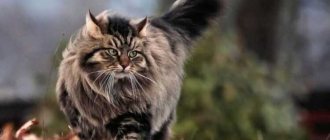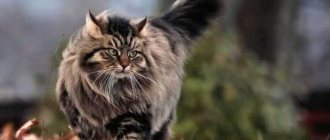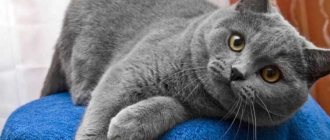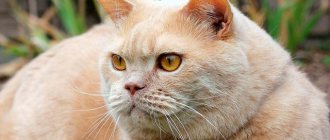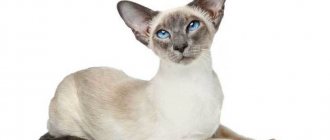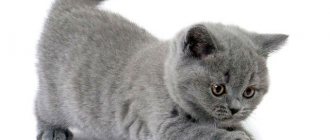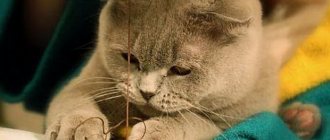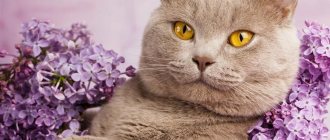The breed was developed at the beginning of the 20th century as a result of hybridization. Found under the names: Lowlanders, Highlanders or simply Britannicas.
The British Longhair cat owes its popularity to its sweet and affectionate character. They are easy to care for and do not shed, but this only applies to purebreds. They have a massive body. short neck and paws. The muzzle is round with a straight nose and large eyes that match the coat color.
Description of the British Longhair cat breed
Popularity 55th place among 86 cat breeds
Lifespan:
9-15 years
Height:
up to 32 cm
Country of origin:
Great Britain
Average price:
35-40 thousand rubles
Weight:
4.5-8 kg
Latest articles Cat care
How to trim a cat's claws correctly and easily 01/28/2022 129 0 0
Dog health
How to do an ultrasound for dogs: preparation and procedure 01/28/2022 59 0 0
Features of color
At exhibitions, strict requirements are put forward for pets. A Briton with a uniform, rich red color is allowed to participate. The hair is uniform throughout its length. The standard allows partial tabby coloring on the forehead in the form of the letter “M”, paws, and tail; inclusions in the form of white wool are rejected. The paw pads and nose are a brick-red, terracotta shade a tone darker than the cat's fur. Eye color is red and yellow.
British shorthair
The British Shorthair cat is characterized by a plush coat, round eyes and small ears. The coat is harsh, dense with a thick, uniformly colored undercoat. Soft is a disadvantage.
Key facts
British longhair cats captivate at first sight - they are large, powerful and beautiful pets that give the impression of impregnable touches. In fact, a cat easily becomes a full-fledged member of the family, gets along well with children and other animals, and patiently endures the whims of its owner.
At the same time, long-haired Britons always try to remain on top and not lose their dignity. A furry friend is ideal for single people who prefer a quiet life. But this does not mean that the Briton is not suitable for active families - on the contrary, it will fit into the general rhythm extremely quickly.
Description of the breed The British Longhair cat combines remarkable external characteristics, self-sufficiency, a peaceful and affectionate character. The main condition for registering a British woman is her absolute purity of the pedigree of at least 4 generations. In the USA and Europe, such individuals already exist in the 3rd generation, but in Russia this is rare - such cases can only be found in short-haired breeds.
Characteristics of the British Longhair cat include many interesting facts:
- Country of origin: England, 19th century. The breed was developed by crossing British Shorthair and Persian cats.
- Traits are friendly, sweet, affectionate and very sociable creatures that get along well with dogs and other pets.
- With proper care, the life expectancy of a British Longhair cat is 15 years.
- Daily care is quite simple. Despite the thick and long hair, the animal does not form tangles, like, for example, Persians.
The only significant disadvantage: the British are gluttons prone to obesity. Fatty meats, legumes, potatoes, and smoked foods should be excluded from your daily diet. Give preference to balanced premium food for long-haired cats.
Pros and cons of the breed
The advantages include a peaceful and flexible character. The British don't like to be squeezed, but they won't hurt children - they'll just hide away from them. These cats are in good health and rarely get sick. The British are very smart, devoid of aggression, and have high intelligence. They do not require constant attention. Cats are very patient, loyal to their owners, and easy to care for.
The British love to eat, which often leads to obesity. Some breeders claim that these cats are hypoallergenic, but this is not true. The British love independence, are sometimes uncontrollable if they want to achieve something themselves, are not very sociable and prefer to be alone.
The disadvantages include some defects in appearance, which are considered serious defects (if breeding is planned) - sunken cheeks, too long and soft hair, pinch, stop on the muzzle, flat forehead, “fox” muzzle. When crossing, only individuals of the same breed are used.
British Longhairs attract attention with their royal appearance. Adults are distinguished by their impressiveness and their own dignity. The British do not cause trouble, easily endure loneliness and moving, and are devoid of aggression. However, they are not suitable for people who often like to “squeeze” their pet in their arms.
History of the origin of the British Longhair cat
The British appeared in England at the beginning of the 19th century by crossing Persians and British shorthair cats. The purpose of the experiment is to obtain an original color.
After three generations, kittens with semi-long and long hair began to be born, looking very much like a Briton. English breeders strictly followed the standard and rejected young longhaired cats.
Fortunately, there were specialists who liked the long hair - cats began to be specially bred for sale. Today, more and more felinological organizations, such as TICA and WCF, have recognized British Longhair cats as an independent and developing breed, after which they have been admitted to international exhibitions.
Nutrition
The British Longhair breed does not have any special requirements. The main thing is to choose the right diet and stick to it. There are special ready-made foods for Highlanders, developed taking into account the characteristics of the breed. Choose only high-quality food that will contain all the necessary vitamins and minerals.
If owners want to feed their pet natural food, then the appropriate requirements must be followed. Remember not to feed homemade food from the table. Milk, salty and smoked foods only disrupt the body’s metabolism and do not provide any benefit to the pet’s health.
What does a British Longhair cat look like?
In appearance, fluffy Britons are similar to their short-haired counterparts. Mature cats have a powerful and large body with a wide chest and straight back, short neck. The animals have massive shoulders and hips. A distinctive feature of the breed is the unusual structure of the muzzle, namely thick cheeks and large bright eyes. Females weigh 3.5-5.5 kg, males reach 6-7 kg.
Muzzle
Even in the photo you can see that the head of a British longhair cat is round and massive, the muzzle is slightly smoothed, but not flattened, the chin is strong, perpendicular to the line of the nose. The ears are widely spaced, small, and round in shape. The nose is straight, short, wide and slightly raised upward.
The calling card of the long-haired British is fluffy, rounded cheeks, as well as skin folds on the neck and belly. The eyes are expressive, large and round, their color matches the color of the animal: it can be emerald, blue, yellow, dark orange or copper. The cat's distinctive whisker pads, well-furred tail and large chin give the cat a special charm.
Body type
Highlanders (the second name for the long-haired British) have a squat and muscular body, a massive, wide back and shoulders, a short and strong neck, and rounded and powerful legs. The tail is 2/3 of the body length, thick at the base and gradually tapers to a rounded tip. Its fluffiness makes it especially attractive.
Coat and color
In purebred animals, the coat is thick, erect and semi-long: shorter on the shoulders and lengthening towards the back. It has a soft texture, does not fit tightly to the body and is a natural protective covering.
The varieties of British Longhair cats in terms of coat color are numerous and varied. The classic colors of the breed are lilac and blue.
The colors of British longhair cats are:
- tortoiseshell
– is an alternation of spots of several shades throughout the body, for example, orange and black or yellow;
- smoky
– the color resembles smoke or chinchilla: the undercoat is snow-white, and the dark color is only at the tip of the hair, while the back, limbs, and head have a more saturated tone;
- tabby
– animals can be striped or spotted and have a ticked pattern, for example, the letter “m” on the forehead; the contrast of shades in the color of the coat is bright;
- bicolor
– when the main tortoiseshell tone, occupying more than ½ of the body, is combined with white, and there is a bright spot on the fluffy face;
- color point
– the animal’s fur is snow-white, and its ears, tail and paws are dark.
There are more than 100 coat colors of the British Longhair. The rare and original color makes the pet more interesting, but in no way distinguishes it as a separate subspecies of the cat genus.
Tortoiseshell color
These cats are distinguished by their spotted colors. These spots can be different: brown, black, orange or even blue. They immediately attract the eye with their spottiness.
- Animal cremation.
What are the benefits of grooming animals?
Ultrasound of animals. Why is it made?
Personality of the British Longhair cat
When you take home a fluffy kitten, you can count on it to grow into a loyal, obedient and affectionate friend. Long-haired British cats play with their owners with pleasure, quickly get used to the tray, and do not require special care or increased care.
Over the years, pets become leisurely and calm, which is manifested in a decrease in their activity and a desire to rest most of the time. Unlike females, British cats remain active much longer, which is due to earlier sexual maturity.
The character of the British Longhair cat is good-natured and accommodating. These are very inquisitive and sedate animals, not devoid of self-respect. They do not show aggression or any intrusiveness, get along well with children, but do not tolerate attention to themselves in the form of constant stroking or being carried in hands.
Cats are very reserved and tolerate loneliness well - long absence of their owners is not a serious problem for them. A purebred cat is well-mannered and smart, she easily adapts to new conditions and feels equally at home in a house and a city apartment.
Character of the breed
Kittens are playful and inquisitive, which cannot be said about adults: older Britons will prefer the sofa to any interesting game.
Highlanders are difficult to piss off. These are very calm and balanced cats. They love solitude and rarely need to communicate with members of their household. Non-conflict: calm towards other pets in the house.
Cats are smart by nature, and therefore raising them and teaching them order will not take much time. The restraint of this breed of cats is surprising: even with severe hunger, the cat will not bother you with meows, begging for food, but will simply sit by an empty bowl.
Cats have a cool calmness. They are humble about crowds when participating in exhibitions. A trip to the veterinarian will also be accepted with equanimity.
They are affectionate, but prefer to sit next to their owner. They are not given in hand. They can withstand the attention of children, although lifting a 5-7 kilogram carcass will be very problematic for a child.
Raising a British Longhair cat
You have become the owner of a gorgeous fluffy dog. What rules of behavior should be instilled in a four-legged friend in the early years of life in order to avoid problems in the future? Many breeders agree that an adult cat must fulfill the following requirements from the owner:
- keep the house clean, only go to the litter box;
- sleep in a designated place;
- respond to your nickname, understand and carry out “command” words;
- do not damage carpets and furniture;
- do not climb on curtains and curtains;
- do not jump on the kitchen and dining table;
- do not steal food from plates;
- do not spoil ornamental plants;
- don't be aggressive.
Raising a British Longhair cat needs to start from an early age so that the animal does not develop stupid habits that will be very difficult to get rid of. When a pet arrives, it is important to immediately let it know who is boss. If the cat can dominate, then this will develop into many problems in the future.
What classical methods should be used in education? Looking at the kitten, repeat the commands in a firm voice and at the same time show what is required of him. For example, when saying “down”, remove the naughty person from the table, window sill, chair where he jumped. Say “no” whenever the animal does something undesirable, such as damaging the carpet with its claws. The business tone of the commands is also important: the kitten must understand its breeder the first time, without numerous repetitions.
If a cat ignores its owner, its behavior should be corrected immediately. Punishment should occur immediately after the offense. You can easily slap the animal on the back with a rolled-up newspaper, this is especially effective when the cat bites its hands or screams loudly.
But due to the specific character of the British Longhair, such methods of punishment should be used in exceptional cases, since the animal can become aggressive, start scratching and snapping unreasonably - or simply avoid the company of its owner.
An effective way is to spray the kitten with water from a spray bottle when, for example, it bites flowers or climbs on a table. Usually a few times are enough for the animal to realize that such behavior is unacceptable in the house. There is no point in attracting attention to yourself - punishment should not be associated with the breeder.
An equally harmful tendency is cat begging and theft. To overcome the problem at an early age, the animal should be fed at the same time, in the designated place and from the same container. Once accustomed to a routine, the kitten will ask for food at certain times and only if it is hungry.
Never throw food at your cat after doing something wrong, otherwise she will take it as encouragement and continue to behave that way. And, of course, give your pet more attention, love, care and warmth - then peace and tranquility in the family are guaranteed.
Diseases
Overall, this breed is hardy and healthy. But there are some genetic diseases and nuances.
- If you bring together cats with different blood groups - A and B - the kittens that are born will live only a few days. The point is this: the mother’s body transmits antibodies to the babies that destroy the blood cells of her babies. American researchers have come up with DNA testing for early ages; this is not yet available in other countries.
- Hypertrophic cardiomyopathy is an enlargement of part of the heart muscle that leads to heart attack and death. This disease can be identified by some characteristic signs: the animal becomes restless, stops running and jumping, it has shortness of breath and a specific cough. The disease cannot be cured, but its timely detection and drug therapy can prolong life for a significant period.
- The tendency to be overweight and obese is common, so teach your pet not to beg for pieces outside of school hours and not to overeat. Plan your diet and try to give your cat more physical activity.
- Tartar is another problem, not fatal, but unpleasant. Weak gums and bad teeth of British cats need to be taken care of from an early age, otherwise in 3-4 years some of the fangs will have to be removed. Take your pet to the veterinarian every six months for an examination and do not refuse professional teeth cleaning.
Young Britons have weak immunity and are easily susceptible to viral and infectious diseases, so don’t delay vaccinations. Rabies, panleukopenia, rhinotracheitis are dangerous diseases that take a long time to treat (or are not treated at all) and require significant financial costs. Annual comprehensive vaccinations will reduce the risk of infection. And don’t forget to give anti-worm medications quarterly!
British Longhair cat health
The British have naturally good health and good stamina. Oncological diseases and other serious illnesses are extremely rare in them.
Possible diseases
A healthy cat means happiness in the family. Longhaired British cats do not bother their caring owners with their illness, this is due to their innate strong immunity. But animals still have some health problems:
- British fluffy cats have a lot of fur - the reason lies in a lack of vitamins, poor diet or pathology of the gastrointestinal tract;
- cats have an excellent appetite and are obese - the solution to the problem will be control of the amount of food by the owner and regular active games;
- hypertrophic cardiomyopathy – regular ultrasound examination of the heart will identify the disease at an early stage and prevent its further development;
- polycystic kidney disease - the disease is inherited, there are no preventive methods.
It is important to give your furry pet all vaccinations in a timely manner, which will protect against most infectious diseases, for example, rabies, panleukopenia, rhinotracheitis, etc. Regularly carry out anthelmintic prophylaxis, and then the health of the British longhair cat throughout its life will not cause concern.
Reproductive health
The first heat of a British Longhair cat can begin at six months - or at one year. This is an individual question. Similarly with the frequency of “walking” - some cats “flow” every 2 weeks, others 3 times a year. In this matter, the hormonal background and heredity of the animal are important.
Usually, after the first mating, 2-4 kittens are born, then up to 6. Sometimes 8-9 fluffy balls are born at once.
If a cat is needed for admiration and communication, it is worth taking care of castration of the male or sterilization of the female at an early age. The ideal time for surgery is 12 months. Until this time, surgical intervention is prohibited, since the reproductive organs are underdeveloped.
Timely castration and sterilization will not affect the health of your long-haired pet: the operation is performed in a specialized clinic by a qualified surgeon. Complications after the intervention are very rare.
Castration and sterilization of British Longhairs
It is necessary to exclude from breeding all animals that do not meet the conformation standards of the breed or have health problems or genetic pathologies. These individuals are subject to mandatory castration or sterilization to avoid unwanted matings.
At what age is it recommended to do it?
British Longhair cats are spayed or neutered at approximately 8–10 months of age. It is very advisable to have time to carry out the operation before the first mating, while the animal’s behavioral habits have not yet fully formed.
If surgery is done too early, your pet may experience developmental delays.
Caring for your pet after surgery
Postoperative care after castration or sterilization is as follows:
- provide the operated animal with peace and quiet;
- limit physical activity to prevent the stitches from coming apart;
- do not feed until the pet has completely recovered from anesthesia (8–10 hours);
- Immediately put an Elizabethan collar or blanket on the cat to prevent it from licking the surgical sutures;
- if the animal is very worried and is in pain, then it is allowed to give painkillers (Pervicox, Ketofen, etc.) as prescribed by a veterinarian;
- clean the seams daily using a cotton swab and any disinfectant solution (hydrogen peroxide, chlorhexidine, etc.).
After the operation, you need to put a blanket on the cat so that he does not lick his stitches.
If any suspicious or unusual situations arise (sutures get wet and fester, body temperature rises, etc.), you should definitely contact a veterinarian to clarify the situation and receive qualified help.
Features of feeding and diet
The general health and appearance of the British Longhair directly depends on a balanced and proper diet.
Your daily diet should include:
- raw and boiled chicken or rabbit meat;
- beef and offal;
- boiled liver;
- sea fish without bones;
- cereal porridges;
- quail and chicken egg white;
- boiled and raw root vegetables, vegetables;
- low-fat fermented milk products without flavoring fillers and chemical dyes;
- special means for removing hairballs from the stomach.
You should not add salt or spices to prepared dishes. It is better to give preference to natural composition. Porridge should be mixed with small pieces of boiled meat or fish.
You can add vegetable oil to boiled vegetables. It is better to avoid butter due to its high fat content. It is important to provide your cat with fresh and clean drinking water.
The following should be excluded from the animal’s daily diet:
- fat meat;
- river fish;
- pickles, smoked meats and sausages;
- flour products;
- potatoes, eggplants;
- raw liver;
- desserts, ice cream and sweets.
The British Longhair can be fed special food with a balanced composition and useful additives. Their range is quite wide; dry and wet food are suitable for everyday feeding.
Cinnamon - red tortoiseshell color in the British
Tortoiseshell coloring is common in British cats. It is formed by a harmonious combination of evenly colored red and black hairs. But in the case of ginger cats, cinnamon (cinnamon) replaces black and goes with any shade of red.
There are no strict rules regarding the size and number of spots in the British tortoiseshell cat color variety. It is genetically impossible to predict how they will lie on the wool, and therefore any arrangement is allowed.
In tri-colored British tortoiseshell cats, white is added to the two standard spot colors (red-black or cinnamon). Such animals are sometimes called patchwork animals, although this definition does not accurately describe their appearance.
Usually female kittens are born with a tortoiseshell color. However, nature sometimes experiments unsuccessfully, and cats become the owners of an additional chromosome (XXY). In this case, they are also born “turtles” and, most likely, will be infertile.
Care and maintenance
British Longhairs give their breeders a lot of warmth and joy, but they also require similar treatment for themselves. Dense and very thick wool causes a lot of trouble. It does not tangle or form tangles, but requires regular brushing with a soft brush.
The procedure should be carried out once every 7 days; in the spring-autumn period, when molting, combing is performed more often. This allows you to keep clothes, furniture and carpets in good condition. During the molting period, the animal licks itself profusely, which causes fur to accumulate in the stomach. To prevent obstruction, you need to give your cat grass or a special paste.
The long-haired British cat does not need frequent washing, since the hair has a natural fatty coating that serves as a barrier to the penetration and proliferation of pathogenic bacteria. The ears and eyes are cleaned with a cotton swab dipped in chilled black tea or lotion. The procedure is carried out several times a week, the claws are trimmed with regular nail clippers once a month.
Unlike many decorative breeds, the British love walks in the fresh air. This is facilitated by their excellent health and immunity. It is better to walk the animal on a harness to avoid being attacked by stray dogs or being run over by a car.
Due to their tendency to obesity (especially after castration), cats need a lot of physical activity. Together with compliance with feeding standards, this gives a positive result.
In general, caring for and maintaining a British longhair cat is not difficult. It is enough to carry out the necessary hygiene procedures in a timely manner and observe the dosage of food.
Genetics of the red (red) color of the British
The British Shorthair breed allows for approximately 250 different color combinations, with solid colors playing a major role. Ginger cats are not unique here, they are often found in litters and were once even quantitatively ahead of the blue-gray color that is considered traditional for the British.
All the tools of the genotype take part in the process of color formation: chromosomes and genes, alleles, loci and pigmentation.
- The main role in the formation of the red color in the British is played by the pigment pheomelanin - elongated ellipsoidal granules that reflect light in the range of red, yellow and orange shades.
- Genes are a library of hereditary data that is passed on from parents to offspring and continues the chain of ancestral connections ad infinitum.
- Alleles come in different forms that genes can take on. They are located on certain parts of the chromosomes - in the example of red British cats, this is a very important point.
- Locus is the location of a gene (allele) in an ordered list of chromosomal compounds.
Find out in detail about cats with red color.
There are 19 pairs of chromosomes in a cat's set. They store the hereditary instructions, and any deviation from the norm ends in an uncontrolled mutation. British redheads are not subject to this risk, as they are an ancient breed with an established genotype.
Genes and chromosomes that influence the formation of red color are distributed as follows:
- The O (orange) gene is responsible for the production of the red pigment pheomelanin in the British (and not only in them). It has only one permanent locus attached to the X chromosome, which determines the sex of the future kitten.
- The O gene exists in 3 alleles: OO (natural red), Oo (red and black tortoiseshell British), oo (red is blocked and does not cause pheomelanin pigmentation). The final example in practice means only one thing - the cat will be black.
- For ginger cats, there are 3 color combination options: OO, oo and Oo. For red British cats, only 2 options are possible - O and O, since they have one X chromosome.
- According to the laws of genetics, a British cat inherits the orange gene from its mother. Therefore, in a pair with a red mother and a blue-gray father, male kittens will definitely receive the properties of the red gene, and the female cats will be tortoiseshell, cream or blue.
This is interesting! There are many more ginger British cats than cats, because boys receive the color gene only from their mother, and girls inherit the properties of both parents.
All British red coats have a tabby pattern on their coats. It is formed under the influence of the A gene (agouti) and exists in two alleles: dominant A and paired homozygous aa. In the second case, agouti suppresses another important component of the genotype - the T (tabby) gene, which is responsible for the ornamentation on the fur coat.
The unique property of the red color is that aa (not agouti) has no effect on it. Therefore, all red British cats are always tabby.
The L gene is also involved in the formation of red color. Thanks to him, purebred British cats have short and thick hair.
Important! The birth of a red or cream female kitten suggests the presence of a dominant O gene in the genotype of two British parents. Only direct pedigree lines influence the external characteristics of the offspring.
Tips for choosing a kitten
The breed of longhaired British cat is very popular in Russia, and buying a kitten does not cause any difficulties. But you can always find an unscrupulous seller offering British longhair kittens with an unclear pedigree and many hereditary diseases. A worthy pet can only be found in a specialized nursery.
It is better to take a kitten from a cat at 2 or 3 months, when the immune system is stronger and the mother has acquired the skills for independent living. At the age of 2.5 months, kittens receive their first rabies vaccination, which must be recorded in the veterinary passport.
When choosing a long-haired British dog, watch its behavior for a while - the animal should be playful and active. Don't forget to inspect the fur: in a healthy kitten it is shiny, soft and smooth. The eyes are clean, without inflammation, the tummy is soft, covered with silky hair.
It is recommended to familiarize yourself with the pedigree of the parents and the documents provided by the breeder. If everything is normal, feel free to buy the baby.
How to choose the right kitten
The paradox of breeding: a long-haired baby can be born not only to Highlanders, but also to short-haired British women - in this case it will be considered as a breed defect and will cost much less. The average price of a show-class kitten is one and a half to two thousand dollars. For that kind of money (or slightly cheaper), scammers can offer you a charming furry “with documents” that will have nothing to do with the breed.
British Longhair kitten - isn't he adorable?
Study the breed standards - after all, at first glance, all fluffy kittens are similar. The British Longhair kitten is most similar to the British Shorthair kitten, which is less difficult to identify. Just imagine the baby being offered to you in a short fur coat - this will help.
British kittens, long-haired and short-haired, look like twin brothers in different coats
But it is more correct, of course, not to rely on your powers of observation, but to buy a baby from a reputable nursery and enter into an official agreement with the breeder, which can largely guarantee the breed of your baby and his hereditary health.
How much does a British Longhair cat cost?
The price of a British longhair cat is quite high: for example, a show-class kitten can be bought for 700-900 US dollars. This breed is popular among collectors; animals with purple coat color are considered especially valuable. The breed class has some disadvantages, but its price is lower than the elite show class and ranges from 400-700 US dollars.
Pet class is much cheaper. But when purchasing, you should clarify why the animal was assigned to him. Is it due to insufficiently thick hair or incorrectly shaped ears? Then you can buy a small pet.
If it is an incorrect bite of the teeth, a crooked tail or paws, it is better to refuse the purchase, despite the tempting price, which can drop to 100-200 dollars.
Do you like the article? 0
Purchasing a British Longhair kitten
Longhaired British cats are not uncommon, so purchasing a kitten now will not be difficult. There are a large number of nurseries and breeders who professionally breed these cats. You can buy a kitten through an advertisement from a private person.
Buying kittens of the longhaired British breed is not difficult.
Criterias of choice
When purchasing, you must first decide what kind of pet you need. Breeders divide kittens into classes:
- show - ideally meet all breed standards, are intended for exhibition activities and breeding, the price for such kittens is the highest and strongly depends on the characteristics of color, gender and specific characteristics of the pedigree;
- breed - have minor flaws in appearance, but are allowed to participate in exhibitions and are used in breeding, they are cheaper;
- pet - in appearance there are serious deviations from breed standards or even defects, which excludes their participation in breeding work, such animals are subject to mandatory castration or sterilization in order to avoid unwanted matings, their cost is low.
Only an experienced breeder and expert can identify a long-haired show-class British kitten.
You can buy a Highlander kitten without documents; such an animal will cost quite a bit. But no one can guarantee that this is a Briton at all, and not just a fluffy mongrel kitten. Only a specialist can accurately determine the class of a small pet, but severe deficiencies (bad bite, high-set ears, curled tail, etc.) can be seen immediately.
British breed kittens must have:
- the head is rounded on a short thick neck, the forehead is wide and round;
- plump, prominent cheeks;
- small round ears;
- the nose is medium without a visible transition in the forehead area;
- the eyes are widely spaced (the color is usually not yet determined);
- the limbs are short, the paws are thick and rounded;
- The coat is elongated, fluffy with a densely packed undercoat.
The small longhaired Briton should be round, heavy and powerful
The baby should give the impression of being round, heavy, powerful and knitted. To confirm the purebred, the breeder is obliged to provide the relevant documents: birth certificate, pedigree, veterinary passport with notes on preventive vaccinations, etc.
It is recommended to look at the entire litter, the kitten's parents, or at least one of them, since the breeder's words should not always be trusted. Sometimes long-haired cubs are born to short-haired British cats. It is impossible to visually distinguish such babies.
By buying a kitten without documents from your own hands, you can buy an ordinary outbred pet
Whatever class the kitten is, the main thing is that it is healthy. You should pay attention to the following signs:
- the baby should be active, not intimidated and lethargic, but not aggressive;
- looks like a teddy bear with shiny, thick and dense fur without matted or stuck together areas;
- the eyes are clean and clear, without any discharge;
- skin without redness, peeling or other damage;
- The ears are clean, without dark plaque.
At what age is it better to adopt a kitten?
It is recommended to purchase kittens after 3–4 months. At this age, they already eat on their own, are accustomed to the tray and scratching post, and also have all the vaccinations appropriate for their age.
It is recommended to purchase kittens after 3–4 months
lop-eared british
Representatives of the Scottish breed have kittens with straight ears. The fold-eared cat becomes later. They are often confused with the British. The breeds are really similar. However, red-haired Britons have small, wide-set, straight ears. The red fold-eared British cat is a myth.
